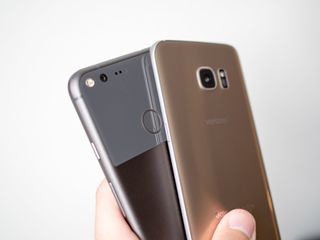Google Pixel vs. Galaxy S7 video stabilization test: Does OIS make a difference?

The Samsung Galaxy S7 and Google Pixel take radically different approaches to stabilizing your videos. On the GS7, you've got traditional optical image stabilization — a hardware feature that cushions the camera module to make video more stable, while also helping out with still shots in darker conditions. In addition, there's traditional software-based video stabilization available in the Settings menu.
On the Pixel, there's no physical stabilization — instead, Google's digital stabilization works with the phone's gyroscope to stabilize footage, with surprisingly great results.
So how do these differing approaches compare? Let's take a look.
Note: We tested both phones at Full HD (1080p) resolution at 30 frames per second, since that's the default setting for both the GS7 and Pixel.
Walking
For our first test, we took the Pixel and Galaxy S7 out for a stroll. Both phones were held one-handed at a moderate walking pace at mid-day on an overcast day.
With stabilization turned off (the default for the GS7), Samsung's phone shows the telltale "wobbling" of an OIS-equipped camera. It's actually not too nauseating, but without any software stabilization going on more susceptible to sudden movements. That said, we're getting a full 1080p image here with plenty of detail, unlike the two stabilized clips.
With stabilization enabled, the footage from the GS7 becomes smoother, but with a cropped-in frame and less fine detail. Sudden movements are still visible in places, but the footage is noticeably smoother.
Be an expert in 5 minutes
Get the latest news from Android Central, your trusted companion in the world of Android
The Pixel produces a less saturated video than the GS7, with dynamic range taking a small hit too (notice the washed-out sky), however footage is almost unnaturally smooth. Google's phone even handles the motion of turning around halfway through the shot relatively well.
Panning
For our next test, we moved each phone through a figure-of-eight motion to see how well they handled smooth movement.
The Galaxy S7 without stabilization captured more fine detail than the other tests, but motion is noticeably jerky throughout. It's pretty unpleasant to watch.
Bring software stabilization into the mix on the GS7 and there's some noticeable ghosting and blurring, but otherwise the movement is smooth.
In this instance, the Pixel offers the best of both worlds — a wider viewport and smooth motion throughout, and nowhere near as much ghosting as the Galaxy S7.
Faster movement
For a more challenging test, we took the phones for a faster walk with dusk approaching. This time around, the Galaxy S7 (without stabilization) probably produced the best-looking footage, although with plenty of OIS-induced wobble.
With software stabilization enabled, the GS7 admirably evens out the jarring motion you see in the first clip, but there's a ton of ghosting, which is probably even more distracting. On top of that, fine detail gets obliterated, leaving you with a very soft image.
The Pixel does slightly better, with more fine detail and less ghosting, but the overall image has a distracting shimmer to it.
Side-by-side comparison
Galaxy S7 and Pixel side-by-side, both with stabilization enabled. Check out the difference.
Low light
Here's where things get interesting. As before, the GS7 without stabilization captures way more fine detail, and in this time around it's easily the best-looking of the three videos, even with lots of motion.
Enabling stabilization on the GS7 in these conditions produces a soft, ghosty, unwatchable mess. (Notice the blurring around the streetlights and headlights.)
The video from the Pixel is still very soft, with not much fine detail at all, but it's easier on the eyes than the stabilized GS7 footage. Colors are also more accurate, a hallmark of the Pixel when shooting in low light.
Wrapping things up
The Google Pixel manages to pull off some pretty impressive stabilization tricks, thanks to its use of data from the phone's gyroscope. By contrast, the Galaxy S7's stabilization mode (disabled by default) degrades image quality much more aggressively. That said, footage from the GS7 without stabilization enabled readily captures more fine detail than the Pixel, with slightly wider dynamic range.
A few conclusions based on our testing:
- Any kind of software stabilization, even as good as the Pixel's, comes with some trade-off in terms of image quality.
- The Pixel's digital stabilization is generally better than the Galaxy S7's, thanks to its use of gyroscope data from the phone.
- Even with OIS, you'll get smoother pans with some kind of software stabilization.
- The impact of digital stabilization becomes more noticeable in lower-light conditions. At night, you'll lose a lot of fine detail.
- If you're shooting on a Galaxy S7, you probably want to leave the "video stabilization" option turned off.
- On the Pixel, video stabilization is enabled by default, and you should probably leave it that way.
Pixel and GS7 owners, how have you found the phones' video cameras? Let us know down in the comments!

Alex was with Android Central for over a decade, producing written and video content for the site, and served as global Executive Editor from 2016 to 2022.
